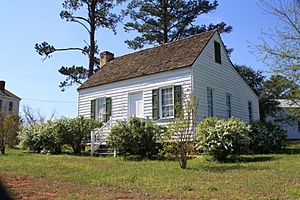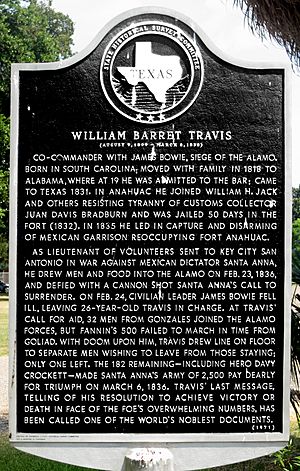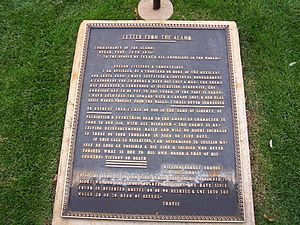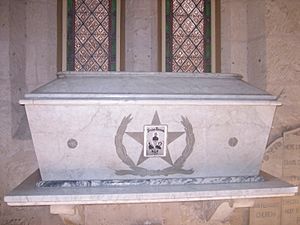William B. Travis facts for kids
Quick facts for kids
William B. Travis
|
|
|---|---|
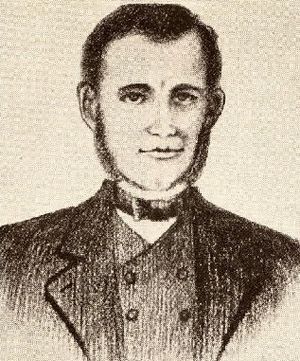
William B. Travis in a sketch by Wyly Martin. This is the only known picture of Travis drawn when he was alive.
|
|
| Birth name | William Barret Travis |
| Nickname(s) | Buck |
| Born | August 1, 1809 Saluda County, South Carolina |
| Died | March 6, 1836 (aged 26) The Alamo, San Antonio, Texas |
| Allegiance | |
| Service/ |
|
| Years of service | 1835–1836 |
| Rank | Lieutenant Colonel |
| Commands held | The Alamo |
| Battles/wars | Texas Revolution Signature of William B. Travis |
William Barret "Buck" Travis (born August 1, 1809 – died March 6, 1836) was an American lawyer and soldier in the 1800s. When he was 26 years old, he was a lieutenant colonel in the Texas Army. He bravely died at the Battle of the Alamo during the Texas Revolution. Travis County and Travis Park were named after him. This was because he was the commander for the Republic of Texas at the Battle of the Alamo.
Contents
Early Life and Education
Growing Up and Learning
William Barret Travis was born on August 1, 1809. His parents were Mark and Jemima Travis. William was one of ten children in his family. When William was nine years old, his family moved to Alabama. They settled in a new town called Sparta.
William's uncle, Alexander Travis, was a very important person in Sparta. He helped start churches and also founded the Sparta Academy. William went to school at Sparta Academy. He studied many subjects, including Greek, Latin, history, and math. After a few years, he moved to another school run by Professor William H. McCurdy.
After finishing school at 18, William worked as a teacher for a short time. He met a student named Rosanna Cato, and they became close.
Life in Claiborne
Starting a Career and Facing Challenges
William Travis wanted to leave farm life behind. He moved to Claiborne, Alabama, which was a busy city near the Alabama River. There, he began to study law with a famous lawyer named James Dellet.
Travis and Rosanna Cato got married on October 26, 1828. Their first son, Charlie, was born a year later.
Travis was eager to start his own career. He started a newspaper called the Claiborne Herald. The newspaper shared news from around the world, local announcements, and advertisements. Travis ran the newspaper mostly by himself. It brought in some money at first, but it was not enough to support his family.
On February 27, 1829, Travis passed his law test and could legally work as a lawyer. He borrowed money to open his law office. He also bought two slaves to help Rosanna with housework, which added to his costs.
His newspaper struggled and eventually stopped printing. His law business did not get many clients. People trusted older, more experienced lawyers like James Dellet more. Travis ended up owing a lot of money.
During this time, Travis heard stories about Texas. Texas was a part of Mexico then, and many people were moving there. There was a big need for lawyers because of all the new settlers and land deals. Travis decided to go to Texas. He told Rosanna, who was expecting their second child, that he would earn enough money to pay off his debts. Travis left for Texas to avoid his debts.
Texas and the Alamo
In May 1831, Travis arrived in Mexican Texas. He bought land from Stephen F. Austin, a key figure in Texas history. Travis opened a law office in Anahuac. He also helped start a group of citizens to oppose Mexican rule. He was even put in prison for his actions during these disagreements.
Travis was made a lieutenant colonel in the Texian army. He was in charge of finding new soldiers. Governor Henry Smith told Travis to gather soldiers to help the Texians at the Alamo Mission in San Antonio.
Travis was not sure about going to the Alamo with so few men and supplies. But he went anyway. On February 3, 1836, Travis arrived in San Antonio with eighteen soldiers. Jim Bowie was already there with 30 men. They decided that Bowie would lead the volunteers, and Travis would lead the regular soldiers. When Bowie became sick, Travis became the main commander of the Alamo.
On March 6, 1836, after a thirteen-day attack, the Mexican army led by Santa Anna stormed the Alamo. Travis fought until the end. He and all the other Alamo defenders died. Their remains were burned.
Travis's "Victory or Death" Letter
On February 24, 1836, while the Alamo was under attack, Travis wrote a famous letter. It was addressed "To the People of Texas and All Americans in the World":
- Fellow citizens and friends;
- I am surrounded by a thousand or more Mexicans under Santa Anna. They have been attacking us for 24 hours, but we have not lost a man. The enemy has demanded that we give up, or they will kill everyone if they take the fort. I answered their demand with a cannon shot, and our flag still flies proudly from the walls. I will never give up or run away. I ask you, in the name of freedom and everything dear to Americans, to come help us quickly. The enemy is getting more soldiers every day and will soon have three or four thousand men. If you do not answer this call, I will fight as long as I can and die like a soldier who always remembers his honor and his country. VICTORY or DEATH.
- William Barret Travis
- Lt. Col. Comdt.
- P.S. God is on our side. When the enemy first appeared, we had very little corn. We have since found 80 or 90 bushels in empty houses and brought 20 or 30 cattle inside the walls.
- Travis
He gave this letter to a messenger named Albert Martin to deliver. The envelope said "VICTORY or DEATH".
The letter did not bring help to the Alamo in time. However, it greatly inspired the Texian army. It also helped gather support in America for Texas to become independent. This letter made Travis a hero of the Texas Revolution.
Where Travis Might Be Buried
A year after the Battle of the Alamo, Colonel Juan Seguín gathered the ashes of the Alamo defenders. On March 28, 1837, there was a public ceremony to bury the ashes. People believed they were buried near the Alamo, but the exact spot was forgotten over time.
In 1936, during renovations at San Antonio's Cathedral of San Fernando, human remains were found. Many believed these were the remains of the Alamo defenders. However, because old records were unclear, some people doubted this. The ashes were placed in a marble tomb inside the cathedral. This tomb is said to hold the bones of Travis, Bowie, Crockett, and others.
Travis's Family
Travis married Rosanna Cato on October 26, 1828. They had a son, Charles Edward, in 1829, and a daughter, Susan, in 1831. They officially divorced on January 9, 1836. Rosanna later married Samuel G. Cloud. Both Rosanna and Samuel died in 1848 from yellow fever.
Charles Edward Travis (1829–1860) was raised by his mother and her second husband. He became a member of the Texas legislature in 1853. He later joined the United States Army as a captain but was discharged. He then studied law and earned a degree from Baylor University in 1859. He died of a lung illness within a year.
Susan Isabella Travis (1831–1868) was born after Travis had left for Texas. Travis named her as his daughter in his will. She married a planter from Chappell Hill, Texas.
Images for kids
See also
 In Spanish: William Barret Travis para niños
In Spanish: William Barret Travis para niños


